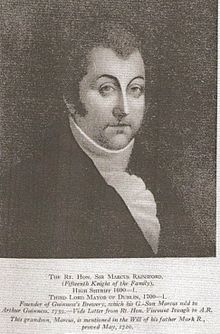Mark Rainsford
Mark Rainsford | |
|---|---|
 Contemporary portrait of Rainsford | |
| Born | 1651 or 1652[1] |
| Died | November 1709 (aged 57)[1] James St, Dublin, Ireland |
| Resting place | St. James Church, James St, Dublin, Ireland |
| Occupation(s) | Brewer, businessman, politician |
| Known for | Owner of what later became the Guinness Brewery |
Sir Mark Rainsford (c. 1652 – November 1709)[1] was an Irish Lord Mayor of Dublin and the owner of what was to later become the Guinness Brewery.[2]
Political career[edit]
Sir Mark Rainsford was Lord Mayor of Dublin from 1700 to 1701. During his term as Lord Mayor, the King William III equestrian statue in College Green, Dublin was unveiled on 1 July 1701.[3][4] He had previously served as High Sheriff of Dublin City in 1689 and 1690.[5]
Professional career[edit]
Rainsford was the owner of what would later become the Guinness Brewery in St. James's Gate, Dublin.[6] His business manufactured 'Beer and Fine Ales' and he was succeeded by his son - also named Mark Rainsford.[6] In 1715, the business was leased to Captain Paul Espinasse.[6] By 1750, the Rainsford family had resumed possession of the business and site.[6] Rainsford's grandson, also called Mark Rainsford, signed over the now famous 9000 year lease to Arthur Guinness on 31 December 1759.[7]
Personal life[edit]
Rainsford was married twice; His first wife was Jane Mee, the daughter of Giles Mee. He had three sons: Edward, Mark, Giles Mee, and several daughters. He acquired land in Portarlington in Queens County (later County Laois) as well as plantations in County Kildare and County Kilkenny.[citation needed]
In 1691, upon the death of his father-in-law, Giles Mee, Rainsford inherited water rights in the district around St. James's Gate and leveraged these rights to undertake his brewing business.[7]
Rainsford was married for a second time, to Isabella Bolton, on 16 May 1695 in St. Michan's Church Dublin.[8] He died in 1709, and Rainsford Street (which stands at the junction of Crane Street and the entrance to Guinness Brewery) was named in his honour.[1]
Images[edit]
-
Thomas Street entrance to St James' Gate Brewery, the site of Rainsford's brewing business
-
King William III statue, unveiled during Rainsford's tenure as Lord Mayor
-
Arms entry of Mark Raynford, Sheriff of City of Dublin, a Captain of Dublin Militia, 24 September 1690
References[edit]
- ^ a b c d Fallon, Donal (12 November 2012). "A Former Lord Mayor: Sir Mark Rainsford". Comeheretome.com (Dublin life & culture). Archived from the original on 11 May 2013. Retrieved 3 December 2012.
- ^ "Rainsford and Wine Room". guinness-storehouse.com. Guinness Storehouse. Archived from the original on 4 November 2011. Retrieved 12 December 2011.
- ^ Ferrar, John (1807). "Chapter II". A view of ancient and modern Dublin, with its latest improvements: to which is added a tour to Bellevue, in the county of Wicklow. p. 34.
- ^ A transcription of the statue's plaque read: "I am seeing here the Third King of Great Britain, France and Hibernia./ For the keeping of Religious Reinstated Laws. / Bring Freedom and this Statue To the eminent citizens of Dublin. / It was begun A.D 1700 Sir Anthony Percy, Lord Mayor. Charles Forrest, James Barlow - Esquires Sheriffs / Finished, A.D 1701 Sir Mark Rainsford, Lord Mayor. John Eceles, Ralph Gore - Esquires Sheriffs"
- ^ Ware, Sir James (1705). The antiquities and history of Ireland By Sir James Ware. A. Crook. p. 172. Retrieved 18 February 2012.
A lift of the Mayors and Sheriffs.
- ^ a b c d Patrick Lynch; John Vaizey; John L. Vaizey, eds. (1960). "The First Arthur Guinness and James's Gate Brewery". Guinness's Brewery in the Irish Economy 1759-1876. p. 69.
- ^ a b Moore, Desmond F. (October 1960). "The Guinness Saga". Dublin Historical Record. 16 (2). Old Dublin Society: 53. JSTOR 30082541.
- ^ Ancestry.com. Ireland, Select Marriages, 1619-1898 [database on-line]. Provo, UT, USA: Ancestry.com Operations, Inc., 2014.



